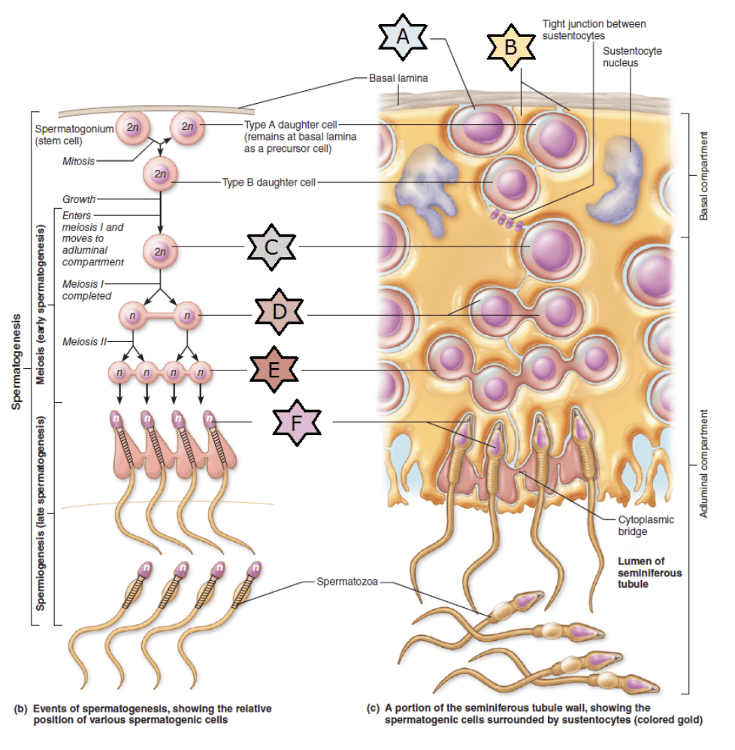
Identify the part of spermatogenesis indicated by "A."
- Primary spermatocyte
- Cytoplasm of adjacent sustentocytes
- Early spermatids
- Spermatogonium
- Late spermatids
- Secondary spermatocyte
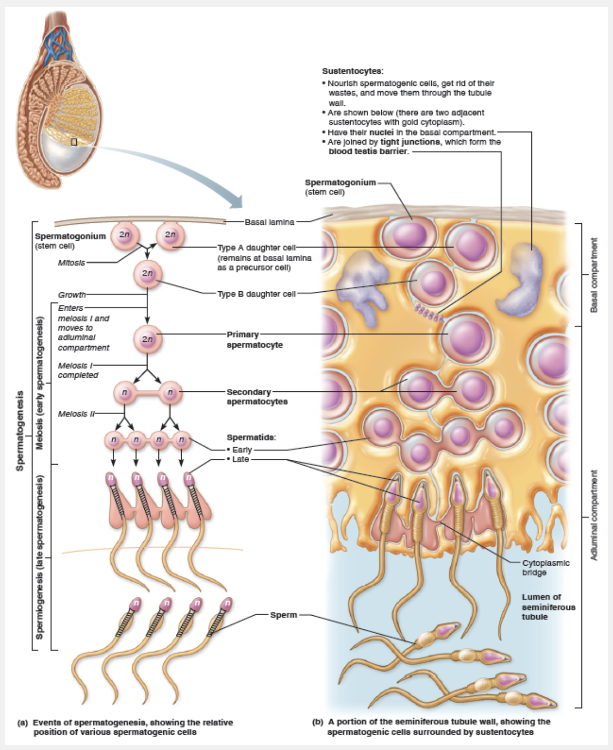
Spermatogonium
Ex.
The part of spermatogenesis indicated by "A" is a spermatogonium .

Identify the part of spermatogenesis indicated by "B."
- Early spermatids
- Secondary spermatocyte
- Spermatogonium
- Late spermatids
- Primary spermatocyte
- Cytoplasm of adjacent sustentocytes

Cytoplasm of adjacent sustentocytes
Ex.
The parts of spermatogenesis indicated by "B" are the cytoplasm of adjacent sustentocytes .

Identify the part of spermatogenesis indicated by "C."
- Spermatogonium
- Primary spermatocyte
- Cytoplasm of adjacent sustentocytes
- Late spermatids
- Early spermatids
- Secondary spermatocyte

Primary spermatocyte
Ex.
The part of spermatogenesis indicated by "C"
is the
primary spermatocyte
.

Identify the part of spermatogenesis indicated by "D."
- Spermatogonium
- Late spermatids
- Cytoplasm of adjacent sustentocytes
- Secondary spermatocyte
- Primary spermatocyte
- Early spermatids

Secondary spermatocyte
Ex.
The part of spermatogenesis indicated by "D" is the secondary spermatocyte .

Identify the part of spermatogenesis indicated by "E."
- Cytoplasm of adjacent sustentocytes
- Primary spermatocyte
- Early spermatids
- Late spermatids
- Secondary spermatocyte
- Spermatogonium

Early spermatids
Ex.
Testicular interstitial endocrine cells produce testosterone.
Sustentocytes deliver nutrients to spermatozoa and make up the blood testis barrier. Spermatogonia give rise to sperm. Estrogen is a female sex hormone.

Identify the part of spermatogenesis indicated by "F."
- Cytoplasm of adjacent sustentocytes
- Spermatogonium
- Late spermatids
- Secondary spermatocyte
- Early spermatids
- Primary spermatocyte

Late spermatids
Ex.
The part of spermatogenesis indicated by "F" are the late spermatids .
Match the phase of meiosis to the event that occurs in the phase: prophase I.
- Tetrads align along the cell's equator.
- Crossovers occur.
- Two haploid daughter cells are formed.
- Homologous chromosomes separate from one another.
- Four genetically unique haploid cells are formed.
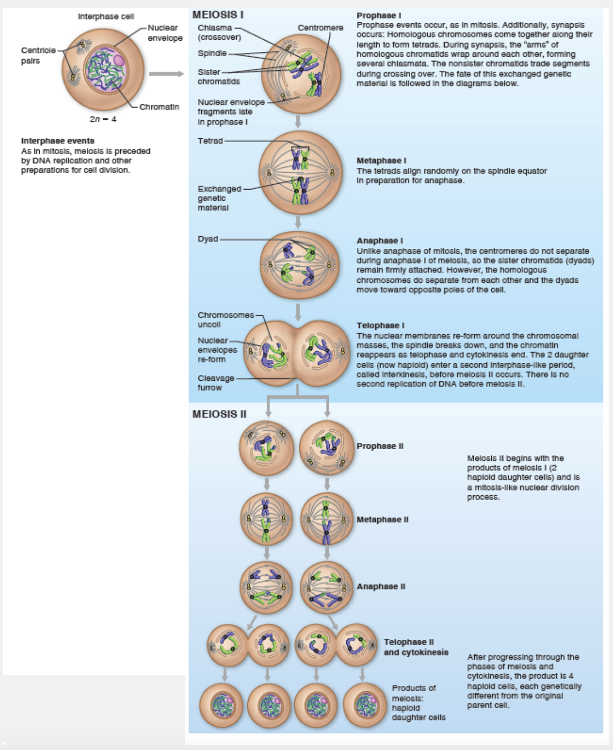
Crossovers occur.
Ex.
Crossovers occur in prophase I.
Match the phase of meiosis to the event that occurs in the phase: Metaphase I.
- Tetrads align along the cell's equator.
- Two haploid daughter cells are formed.
- Four genetically unique haploid cells are formed.
- Homologous chromosomes separate from one another.
- Crossovers occur.

Tetrads align along the cell's equator.
Ex.
In metaphase I, tetrads align along the cell’s equator.
During metaphase I, the tetrads line up randomly at the spindle equator, so that either the paternal or maternal chromosome can be on a given side. During anaphase I, the sister chromatids representing each homologue behave as a unit—almost as if replication had not occurred—and the homologous chromosomes, each still composed of two joined sister chromatids (a dyad), are distributed to opposite ends of the cell.
Match the phase of meiosis to the event that occurs in the phase: Anaphase I.
- Crossovers occur.
- Tetrads align along the cell's equator.
- Four genetically unique haploid cells are formed.
- Two haploid daughter cells are formed.
- Homologous chromosomes separate from one another.

Homologous chromosomes separate from one another.
Ex.
As shown in the figure, during anaphase I, homologous chromosomes separate from one another.
Match the phase of meiosis to the event that occurs in the phase: Telophase I.
- Crossovers occur.
- Two haploid daughter cells are formed.
- Tetrads align along the cell's equator.
- Four genetically unique haploid cells are formed.
- Homologous chromosomes separate from one another.

Two haploid daughter cells are formed.
Ex.
As shown in the figure, during telophase I, two haploid daughter cells are formed.
Match the phase of meiosis to the event that occurs in the phase: Telophase II.
- Crossovers occur.
- Homologous chromosomes separate from one another.
- Four genetically unique haploid cells are formed.
- Two haploid daughter cells are formed.
- Tetrads align along the cell's equator.

Four genetically unique haploid cells are formed.
Ex.
As shown in the figure, during telophase II, four genetically unique haploid cells are formed.
The area of the sperm cell that contains many mitochondria is the __________.
- head
- tail
- midpiece
- acrosome
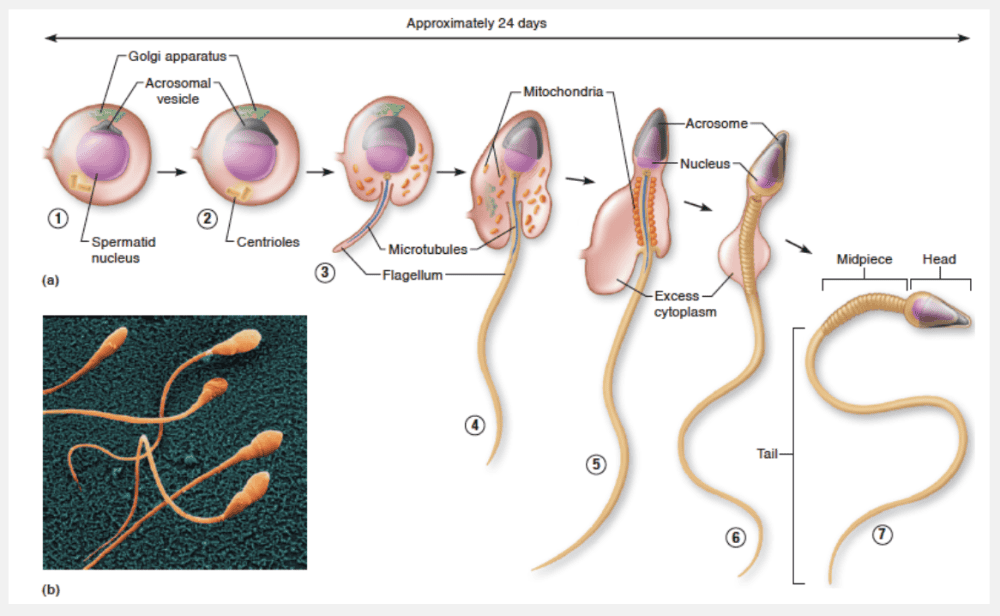
midpiece
Ex.
The area of the sperm cell that contains many mitochondria is the midpiece.
Each resulting sperm, or spermatozoon (sper”mah-tozo’ on; “animal seed”), has a head, midpiece, and tail, which correspond roughly to genetic, metabolic, and locomotor regions, respectively. Sperm “pack” lightly.
The head of a sperm consists almost entirely of its flattened nucleus, which contains the compacted DNA. A helmetlike acrosome (ak’ro-sōm; “tip piece”) adheres to the top of the nucleus. Like a lysosome, the acrosome contains hydrolytic enzymes that, in this case, enable the sperm to penetrate and enter an egg.
The sperm midpiece contains mitochondria spiraled tightly around the microtubules of the tail. The long tail is a typical flagellum produced by one centriole (actually a basal body). The mitochondria provide the metabolic energy (ATP) needed for the whiplike movements of the tail that will propel the sperm along its way in the female reproductive tract.
Which of the following statements is TRUE about the testicular interstitial endocrine cells?
- Make up the blood testis barrier
- Produce sperm
- Produce testosterone
- Produce estrogen
- Deliver nutrients to the spermatozoa
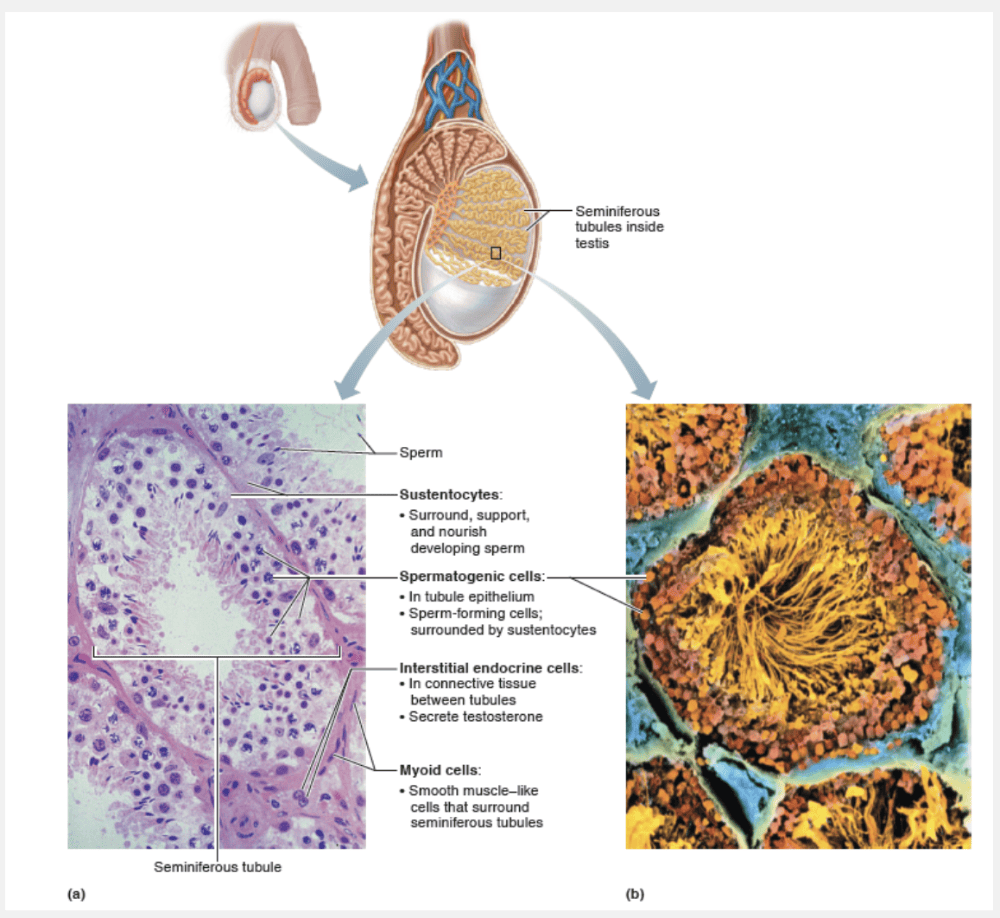
Produce testosterone
Ex.
Testicular interstitial endocrine cells produce testosterone.
Sustentocytes deliver nutrients to spermatozoa and make up the blood testis barrier. Spermatogonia give rise to sperm. Estrogen is a female sex hormone.`
Which of the following is true about meiosis?
- Meiosis produces cells that have a haploid chromosome number.
- Meiosis leads to the production of genetically identical cells.
- Meiosis is how most cells in the body divide.
- Meiosis involves only one cell division event.
Meiosis produces cells that have a haploid chromosome number.
Ex.
Meiosis produces cells that have a haploid chromosome number is a true statement.
Gamete formation in both sexes involves meiosis, a unique kind of nuclear division that occurs only in the gonads. One main function of meiosis is to reduce the number of chromosomes in gametes by half. The haploid chromosome number for humans is 23. The second function of meiosis is to greatly increase the genetic variability of gametes. Meiosis consists of two rounds of cell division, Meiosis I and Meiosis II.
The sperm's acrosome __________.
- contains nutrients
- has a high density of mitochondria
- contains enzymes
- provides the blood-testis barrier
- beats, so that the sperm can swim

contains enzymes
Ex.
The sperm's acrosome contains enzymes.
The head of a sperm consists almost entirely of its flattened nucleus, which contains the compacted DNA. A helmetlike acrosome (ak′ro-sōm; “tip piece”) adheres to the top of the nucleus. Like a lysosome, the acrosome contains hydrolytic enzymes that, in this case, enable the sperm to penetrate and enter an egg.
Which male accessory gland produces an alkaline fluid containing fructose sugar?
- Surrounds urethra
- None of the choices are correct
- Produces sperm
- Bulbo-urethral gland
- Seminal gland
- Prostate
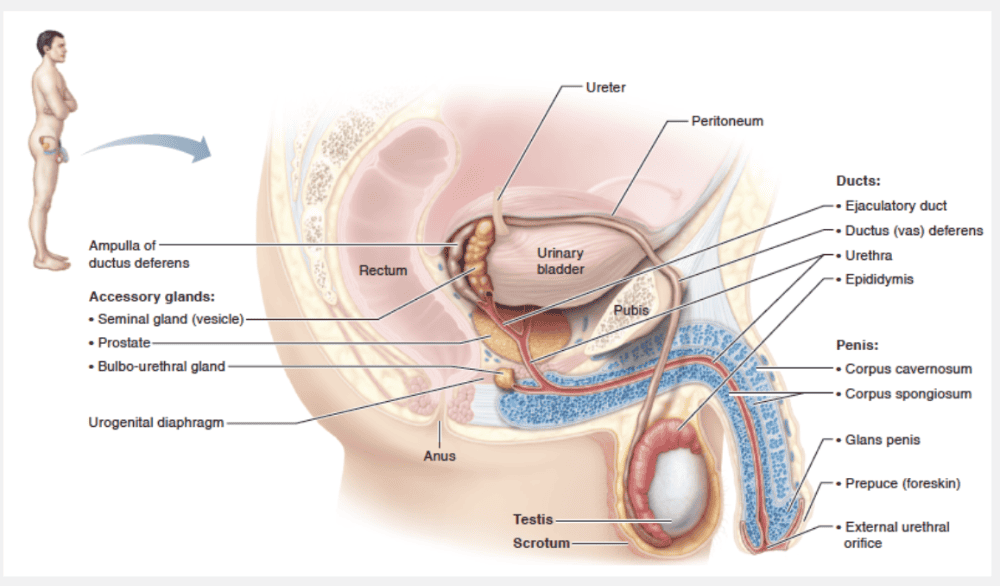
Seminal gland
Ex.
The seminal glands produce an alkaline fluid containing fructose sugar.
Sperm and seminal fluid from the seminal gland mix in the ejaculatory duct and enter the prostatic urethra together during ejaculation. This secretion is an alkaline fluid containing fructose sugar, citric acid, a coagulating enzyme, prostaglandins, and other substances that increase sperm motility or fertilizing ability. The paired bulbo-urethral glands duct into the spongy urethra to neutralize traces of acidic urine. In addition, this mucus lubricates the glans penis when a man becomes sexually excited. During ejaculation, the prostate secretes into the prostatic urethra via several ducts. This fluid plays a role in activating sperm and accounts for up to one-third of the semen volume. It is a milky, slightly acidic fluid that contains citrate (a nutrient source) and several enzymes including one called prostate-specific antigen (PSA).
Which of the following is FALSE about sustentocytes?
- Produce testosterone
- Are bound to each other laterally by tight junctions
- Deliver nutrients to spermatocytes
- Divide the seminiferous tubules into two compartments
- Help form the blood testis barrier

Produce testosterone
Ex.
It is FALSE that sustentocytes produce testosterone.
The sustentocytes are bound to each other laterally by tightjunctions. In this way, they divide the seminiferous tubule into two compartments:
- The basal compartment extends from the basal lamina to the tight junctions and contains spermatogonia and the earliestprimary spermatocytes.
- The adluminal compartment lies internal to the tight junctionsand includes the meiotically active cells and the tubule lumen. The tight junctions between the sustentocytes form the bloodtestis barrier. This barrier prevents the membrane antigens of differentiating sperm from escaping through the basal lamina into the bloodstream where they could activate the immunesystem. Interstitial endocrine cells produce testosterone.
Conversion of haploid spermatids to spermatozoa is specifically called __________.
- mitosis
- spermiogenesis
- meiosis
- spermatogenesis

spermiogenesis
Ex.
Conversion of haploid spermatids to spermatozoa is specifically called spermiogenesis.
Each spermatid has the correct chromosomal number for fertilization (n), but is nonmotile. It still must undergo a streamlining process called spermiogenesis, during which it elongates, sheds its excess cytoplasmic baggage, and forms a tail. Follow the details of this process in the figure below.
Each resulting sperm, or spermatozoon (sper”mah-tozo’ on; “animal seed”), has a head, midpiece, and tail, which correspond roughly to genetic, metabolic, and locomotor regions, respectively.
Which male accessory gland produces a thick, clear mucus that lubricates the glans penis during sexual excitement?
- All of the choices are correct
- Seminal gland
- Bulbo-urethral gland
- FSH production
- Prostate
- Site of implantation

Bulbo-urethral gland
Ex.
The bulbo-urethral glands produce a thick, clear mucus that lubricates the glans penis during sexual excitement.
The paired bulbo-urethral glands duct into the spongy urethra to neutralize traces of acidic urine. In addition, this mucus lubricates the glans penis when a man becomes sexually excited. During ejaculation, the prostate secretes into the prostatic urethra via several ducts. This fluid plays a role in activating sperm and accounts for up to one-third of the semen volume. It is a milky, slightly acidic fluid that contains citrate (a nutrient source) and several enzymes including one called prostate-specific antigen (PSA). Sperm and seminal fluid from the seminal gland mix in the ejaculatory duct and enter the prostatic urethra together during ejaculation. This secretion is an alkaline fluid containing fructose sugar, citric acid, a coagulating enzyme, prostaglandins, and other substances that increase sperm motility or fertilizing ability.
Correctly match the following: Prepuce.
- Tip of the penis
- Foreskin of the penis
- Shaft of the penis
- Bulb of the penis
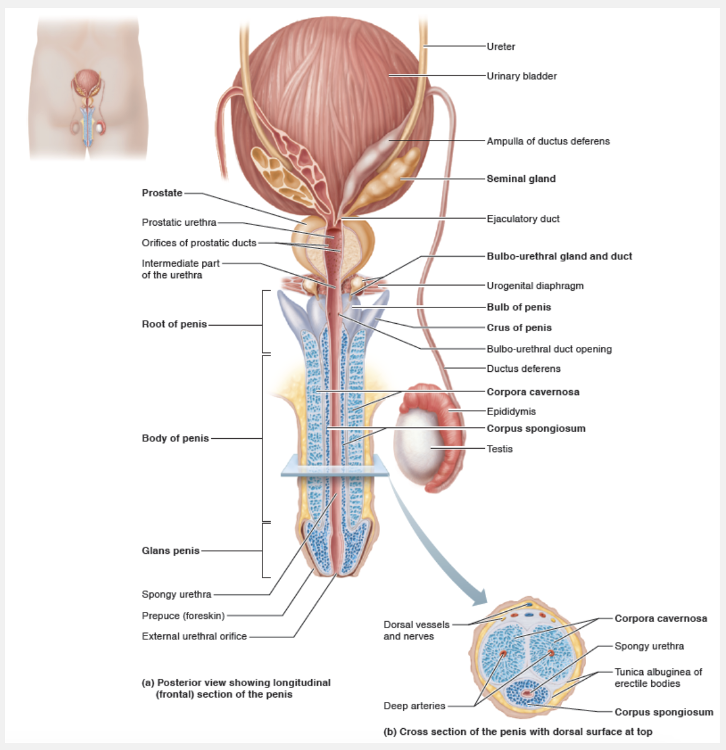
Foreskin of the penis
Ex.
The prepuce is the foreskin of the penis.
The penis consists of an attached root and a free body that ends in an enlarged tip, the glans penis. The skin covering the penis is loose, and extends distally around the glans to form a cuff called the prepuce (pre’pūs), or foreskin.
Sometimes, the foreskin is surgically removed shortly after birth, a procedure called circumcision (“cutting around”). While circumcision is not medically necessary, it has been shown to decrease the risk of acquiring HIV. It also significantly reduces the risk of other reproductive system infections. About 60% of newborn boys in the United States are circumcised.